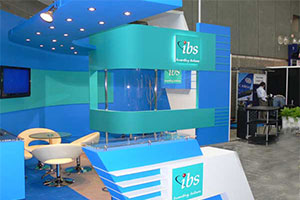Exhibition stand design and build
-
Call Us On
0049 69 257378649
-
Mail Us @
Exhibition booths design and planning
Design a pleasing and efficient booth

When developing an exhibition booth design it is vital to imagine the booth indoor as a oneness. A set of areas connected together. Hence, it is proper that a common style and design runs around. All interior planning components should come together and match each other, to strengthen the whole structure. An effective way to generate this theme is the well deemed application of color. Color schemes in overall are an excellent way to unify a sections of spaces. For instance, you may choose three or four colors and use them in different shades throughout the stand.
Designing an exhibition booth is a creative task that evaluates customer’s information, determines a visual direction, refines the design direction, and generates graphic interaction.
Balance is definitely the equivalent dispersal of aesthetic effects in a booth. There are three styles of harmony: radial, regular and asymmetrical.
Inner design is the procedure of shaping the experience of interior space, through the conception of spatial size in addition to surface development. Interior booth design draws on aspects of environmental psychology, architecture, and product design in addition to regular decoration.
Regular balance is normally included in conventional interiors. Symmetrical equilibrium is characterized by identical objects repeated in a similar positions on each side, for example you may remember old rooms where on every side of a space is an exact mirror of the other. This symmetry also reflects a person’s form, so we are innately pleasant inside of a balanced environment.
The focus should dominate the design with scale and contrast without leaving behind the oneness of the whole space. This is actually the instant place where your eye is drawn to as you enter the booth. This can be a built in feature such as product area the conversation view through a window or decor accessories such as artworks with product information and slogans might also be a central point. Balance, in relation to interior booth design, is often outlined as the general concept of aesthetic sense of balance, which, in turn, acts in relation to our particular and physical sense of balance.
Steadiness can also be used in three-dimensional elements at the same time, and it is quite simple to implement. Basically, an object will finally tip above if correct and correct balance is not realized. In terms of two-dimensional aspects, it’s important to keep in mind that the best method to let three-dimensional aspects is to use your imagination.
Regarding visual aspects very cautious concern is always given when it comes to setting certain objects within any indoor space. The following are what commonly determines the visual aspects of an exhibition booth.
Asymmetrical balance is far more appropriate in design presently. Balance is accomplished with some diverse objects that have identical visual weight or eye appeal. Asymmetrical harmony is more informal and less contrived in feeling, but a lot more difficult to accomplish. Asymmetry implies movement, and leads to more energetic interiors.
Radial symmetry is the place where all the components of a design are arrayed around a center point. A spiral staircase is also an excellent example of radial balance. Though not often employed in interiors, it can deliver an exciting counterpoint if used appropriately.
A cluster of candles of varying sizes on a simple tray creates interest because of the natural progression shown. You can also achieve progression via color, such as in a monochromatic color scheme where each component is a a little different shade of identical color.
Transition is a little tougher to define. Unlike duplication or further development, transition tends to be a smoother flow, where the eye naturally glides from one area to another. The most prevalent change is the use of a curved line to carefully guide the eye, such as a curved doorway or winding path.
Contrast is reasonably easy. Placing two elements next to one another, Opposition can also be suggested by contrasts in shape, such as circles and squares applied together. Contrast is often rather grates on, and is typically used to enliven a space. Be mindful not to undo any difficult work you have done while using other components by adding too much contrast!
An additional crucial element of exhibition booth interior design where it is required to take infinite pains is details. Anything from the trimming on the lamp shade, along with of the entrances, counters, towards light switches and shelves handles consideration. Unlike color people see some details monotonous.
As a result it gets ignored and skimmed over or generally left out. As color states the complete spirit and life of a scheme; information and facts are just as important as the interior booth design. Details shouldn’t be obvious but they must be right, improving the total sense of a booth. [content]
Size and Proportion
These design ideas go hand in hand, given that each relate to size and shape. Proportion has to do with the rate of one design component to another, or one element to the whole booth. Scale queries itself with the size of one object compared to another. These actions will ensure the design and development of a harmonic and effective exhibition booth.
Last Updated on April 18, 2023 by Traxor-designs
